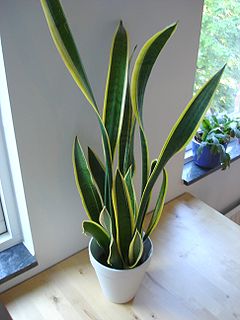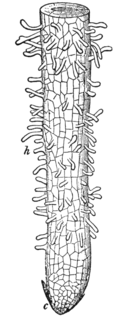
Hydroponics is a subset of hydroculture, which is a method of growing plants without soil by instead using mineral nutrient solutions in a water solvent. Terrestrial plants may be grown with only their roots exposed to the nutritious liquid, or the roots may be physically supported by an inert medium such as perlite or gravel.

In vascular plants, the root is the organ of a plant that typically lies below the surface of the soil. Roots can also be aerial or aerating, that is, growing up above the ground or especially above water. Furthermore, a stem normally occurring below ground is not exceptional either. Therefore, the root is best defined as the non-leaf, non-nodes bearing parts of the plant's body. However, important internal structural differences between stems and roots exist.

Permaculture is a set of design principles centered on whole systems thinking, simulating, or directly utilizing the patterns and resilient features observed in natural ecosystems. It uses these principles in a growing number of fields from regenerative agriculture, rewilding, and community resilience.

Bonsai is a Japanese art form using cultivation techniques to produce, in containers, small trees that mimic the shape and scale of full size trees. Similar practices exist in other cultures, including the Chinese tradition of penzai or penjing from which the art originated, and the miniature living landscapes of Vietnamese Hòn Non Bộ. The Japanese tradition dates back over a thousand years.

Topsoil is the upper, outermost layer of soil, usually the top 5 inches (13 cm) to 10 inches (25 cm). It has the highest concentration of organic matter and microorganisms and is where most of the Earth's biological soil activity occurs. Topsoil is composed of mineral particles, organic matter, water, and air. Organic matter varies in quantity on different soils. The strength of soil structure decreases with the presence of organic matter, creating weak bearing capacities. Organic matter condenses and settles in different ways under certain conditions, such as roadbeds and foundations. The structure becomes affected once the soil is dewatered. The soil's volume substantially decreases. It decomposes and suffers wind erosion.

A tropical garden features tropical plants and requires good rainfall or a decent irrigation or sprinkler system for watering. These gardens typically need fertilizer and heavy mulching.

A houseplant is a plant that is grown indoors in places such as residences and offices, namely for decorative purposes, but studies have also shown them to have positive psychological effects and as well as help with indoor air purification, since some species, and the soil-dwelling microbes associated with them, reduce indoor air pollution by absorbing volatile organic compounds including benzene, formaldehyde, and trichloroethylene. While generally toxic to humans, such pollutants are absorbed by the plant and its soil-dwelling microbes without harm.

A root hair, or absorbent hair, the rhizoid of a vascular plant, is a tubular outgrowth of a trichoblast, a hair-forming cell on the epidermis of a plant root. As they are lateral extensions of a single cell and only rarely branched, they are visible to the naked eye and light microscope. They are found only in the region of maturation of the root. Just prior to, and during, root hair cell development, there is elevated phosphorylase activity. Plants absorb water from the soil by osmosis. Root hair cells are adapted for this by having a large surface area to speed up osmosis. Another adaptation that they have is root hair cells have a large permanent vacuole.

Layering has evolved as a common means of vegetative propagation of numerous species in natural environments. Layering is also utilized by horticulturists to propagate desirable plants.

Container gardening or pot gardening is the practice of growing plants, including edible plants, exclusively in containers instead of planting them in the ground. A container in gardening is a small, enclosed and usually portable object used for displaying live flowers or plants. It may take the form of a pot, box, tub, pot, basket, tin, barrel or hanging basket.
This is an alphabetical index of articles related to gardening.
Uses of compost describes the range of beneficial uses for compost. Compost is a versatile product resulting from composting - the biodegradation of organic waste at household, community or citywide level. Composting can be carried out at the household level, in garden composters or in composting toilets, or at municipal level at centralised composting plants. The method of producing the compost has an influence on its possible uses in terms of quantity and quality considerations.

A flowerpot, flower pot, or plant pot is a container in which flowers and other plants are cultivated and displayed. Historically, and still to a significant extent today, they are made from terracotta. Flowerpots are now often also made from plastic, wood, stone, or sometimes biodegradable material. An example of biodegradable pots are ones made of heavy brown paper, cardboard, or peat moss in which young plants for transplanting are grown.

Saikei (栽景) literally translates as "planted landscape". Saikei is a descendant of the Japanese arts of bonsai, bonseki, and bonkei, and is related less directly to similar miniature-landscape arts like the Chinese penjing and the Vietnamese hòn non bộ. It is the art of creating tray landscapes that combine miniature living trees with soil, rocks, water, and related vegetation in a single tray or similar container. A saikei landscape will remind the viewer of a natural location through its overall topography, choice of ground materials, and the species used in its plantings.
An olla is a ceramic jar, often unglazed, used for cooking stews or soups, for the storage of water or dry foods, or for other purposes. Ollas have short wide necks and wider bellies, resembling beanpots or handis.

Pinguicula primuliflora, commonly known as the southern butterwort or primrose butterwort, is a species of carnivorous plant belonging to the genus Pinguicula. It is native to the southeastern United States. The typical variety forms a white flower in blooming. Like other butterworts, it has sticky adhesive leaves which attract, capture and digest arthropod prey in order to supply the plant with nutrients such as nitrogen not found in the nutrient poor, acidic soil that it grows in. Its name derives from the fact it is usually the first one to flower in the spring.
Ebb and Flow are two phases of the tide or any similar movement of water. The Ebb is the outgoing phase, when the tide drains away from the shore; and the flow is the incoming phase when water rises again. The terms are also common in figurative use.
Sand-based athletic fields are sports turf playing fields constructed on top of sand surfaces. It is important that turf managers select the most suitable type of sand when constructing these fields, as sands with different shapes offer varied pros and cons. Regular maintenance of sand-based athletic fields is just as important as the initial construction of the field. As water and other aqueous solutions are added, a layer of thatch may accumulate on the surface of the turf. There are different ways to manage this level of thatch, however the most common are aeration and vertical mowing.

Campanula poscharskyana, the Serbian bellflower or trailing bellflower, is a semi-evergreen trailing perennial, valued for its lavender-blue star-shaped flowers, native to the Dinaric Alps in former Yugoslavia.

Bonsai cultivation and care involves the long-term cultivation of small trees in containers, called bonsai in the Japanese tradition of this art form. Similar practices exist in other Japanese art forms and in other cultures, including saikei (Japanese), penjing (Chinese), and hòn non bộ (Vietnamese). Trees are difficult to cultivate in containers, which restrict root growth, nutrition uptake, and resources for transpiration. In addition to the root constraints of containers, bonsai trunks, branches, and foliage are extensively shaped and manipulated to meet aesthetic goals. Specialized tools and techniques are used to protect the health and vigor of the subject tree. Over time, the artistic manipulation of small trees in containers has led to a number of cultivation and care approaches that successfully meet the practical and the artistic requirements of bonsai and similar traditions.















